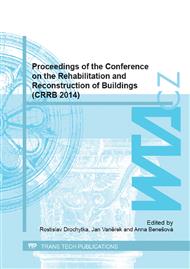[1]
A.Z. Miller, P. Sanmartín, L. Pereira-Pardo, A. Dionísio, C. Saiz-Jimenez, M.F. Macedo, et al., Bioreceptivity of building stones: A review, Sci. Total Environ. 426 (2012) 1-12.
DOI: 10.1016/j.scitotenv.2012.03.026
Google Scholar
[2]
M.E. Puente, M.C. Rodriguez-Jaramillo, C.Y. Li, Y. Bashan, Image analysis for quantification of bacterial rock weathering, J. Microbiol. Methods. 64 (2006) 275-286.
DOI: 10.1016/j.mimet.2005.05.007
Google Scholar
[3]
N.A. Cutler, A.E. Oliver, H.A. Viles, S. Ahmad, A.S. Whiteley, The characterisation of eukaryotic microbial communities on sandstone buildings in Belfast, UK, using TRFLP and 454 pyrosequencing, Int. Biodeterior. Biodegrad. 82 (2013) 124-133.
DOI: 10.1016/j.ibiod.2013.03.010
Google Scholar
[4]
P. Guiamet, M. Crespo, P. Lavin, B. Ponce, C. Gaylarde, S.G. de Saravia, Biodeterioration of funeral sculptures in La Recoleta Cemetery, Buenos Aires, Argentina: Pre- and post-intervention studies, Colloids Surf. B Biointerfaces. 101 (2013).
DOI: 10.1016/j.colsurfb.2012.06.025
Google Scholar
[5]
V. Jurado, A.Z. Miller, S. Cuezva, A. Fernandez-Cortes, D. Benavente, M.A. Rogerio-Candelera, et al., Recolonization of mortars by endolithic organisms on the walls of San Roque church in Campeche (Mexico): A case of tertiary bioreceptivity, Constr. Build. Mater. 53 (2014).
DOI: 10.1016/j.conbuildmat.2013.11.114
Google Scholar
[6]
R. Wasserbauer, M. Gregerová, Charles Bridge Biocorrosion In: Kontra 2002. Warszawa: Komitet Trwalosci Budowli ZG PZITB, 2002, pp.257-262.
Google Scholar
[7]
M. Gregerová, M. Brtnický, E. Burgetová, et al., Degradace stavebních materiálů historických památek (Degradation of building materials of historical monuments), part I. Brno: Mendelova univerzita v Brně, Brno, (2012).
Google Scholar
[8]
Lindquist, J., 2009, An Introduction to Bacterial Identification University of Wisconsin, USA www. jlindquist. net/generalmicro.
Google Scholar
[9]
E. Bock, W. Sand, The microbiology of masonry biodeterioration, J. Appl. Bacteriol. 74 (1993) 503-514.
Google Scholar
[10]
A.G. Nord, T. Ericsson, Chemical analysis of thin black layers on building stone, Studies in conservation, 38 (1993) 25-35.
DOI: 10.1179/sic.1993.38.1.25
Google Scholar


